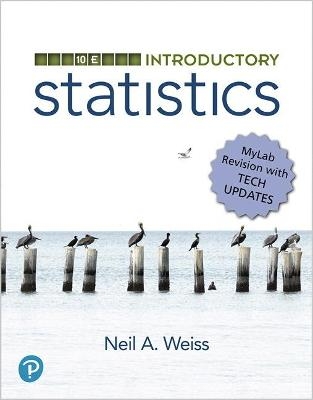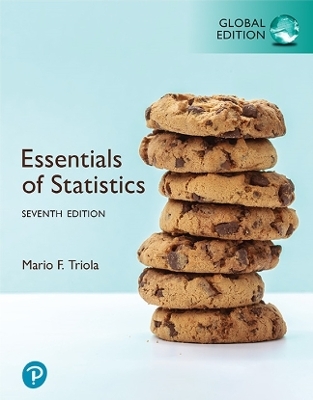
MyLab Statistics with Pearson eText Access Code (24 Months) for Introductory Statistics, MyLab Revision
Pearson (Hersteller)
978-0-13-519017-3 (ISBN)
- Titel z.Zt. nicht lieferbar
- Versandkostenfrei innerhalb Deutschlands
- Auch auf Rechnung
- Verfügbarkeit in der Filiale vor Ort prüfen
- Artikel merken
This item is an access card for MyLab™ Statistics. This physical access card includes an access code for your MyLab Statistics course. In order to access the online course you will also need a Course ID, provided by your instructor.
This title-specific access card provides access to the Weiss, Introductory Statistics, MyLab Revision, 10/e accompanying MyLab course ONLY.
0135190177 / 9780135190173 MYLAB STATISTICS WITH PEARSON ETEXT -- STANDALONE ACCESS CARD -- FOR INTRODUCTORY STATISTICS, MYLAB REVISION , 10/e
MyLab Statistics is the world’s leading online tutorial, and assessment program designed to help you learn and succeed in your statistics course. MyLab Statistics online courses are created to accompany one of Pearson’s best-selling math textbooks. Every MyLab Statistics course includes a complete, interactive eText. Learn more about MyLab Statistics.
ALERT:
Before you purchase, check with your instructor or review your course syllabus to ensure that you select the correct ISBN.
Used or rental books
If you rent or purchase a used book with an access code, the access code may have been redeemed previously and you may have to purchase a new access code.
Access codes
Access codes that are purchased from sellers other than Pearson carry a higher risk of being either the wrong ISBN or a previously redeemed code. Check with the seller prior to purchase.
About our author The late Neil A. Weiss received his Ph.D. from UCLA and subsequently accepted an assistant professor position at Arizona State University (ASU), where he was ultimately promoted to the rank of full professor. Dr. Weiss taught statistics, probability, and mathematics, from the freshman level to the advanced graduate level, for more than 30 years. In recognition of his excellence in teaching, Dr. Weiss received the Dean's Quality Teaching Award from the ASU College of Liberal Arts and Sciences. He also was runner-up twice for the Charles Wexler Teaching Award in the ASU School of Mathematical and Statistical Sciences. Dr. Weiss's comprehensive knowledge and experience ensure that his texts are mathematically and statistically accurate, as well as pedagogically sound. In addition to his numerous research publications, Dr. Weiss was the author of A Course in Probability (Addison-Wesley, 2006). He also authored or coauthored books in finite mathematics, statistics and real analysis. His texts, well known for their precision, readability and pedagogical excellence, are used worldwide. Dr. Weiss was a pioneer of the integration of statistical software into textbooks and the classroom, first providing such integration in the book Introductory Statistics (AddisonWesley,1982). Since this first publication, Neil Weiss's work continues to inspire future statisticians and current students of statistics alike.
* Indicates optional material.
** Indicates optional material on the WeissStats site.
PART I: INTRODUCTION
1. The Nature of Statistics
Case Study: Top Films of All Time
1.1 Statistics Basics
1.2 Simple Random Sampling
1.3 Other Sampling Designs*
1.4 Experimental Designs*
Chapter in Review
Review Problems
Focusing on Data Analysis
Case Study Discussion
Biography
PART II: DESCRIPTIVE STATISTICS
2. Organizing Data
Case Study: World's Richest People
2.1 Variables and Data
2.2 Organizing Qualitative Data
2.3 Organizing Quantitative Data
2.4 Distribution Shapes
2.5 Misleading Graphs*
Chapter in Review
Review Problems
Focusing on Data Analysis
Case Study Discussion
Biography
3. Descriptive Measures
Case Study: The Beatles' Song Length
3.1 Measures of Center
3.2 Measures of Variation
3.3 Chebyshev's Rule and the Empirical Rule*
3.4 The Five-Number Summary; Boxplots
3.5 Descriptive Measures for Populations; Use of Samples
Chapter in Review
Review Problems
Focusing on Data
Analysis
Case Study Discussion
Biography
PART III: PROBABILITY, RANDOM VARIABLES, AND SAMPLING DISTRIBUTIONS
4. Probability Concepts
Case Study: Texas Hold'em
4.1 Probability Basics
4.2 Events
4.3 Some Rules of Probability
4.4 Contingency Tables; Joint and Marginal Probabilities*
4.5 Conditional Probability*
4.6 The Multiplication Rule; Independence*
4.7 Bayes's Rule*
4.8 Counting Rules*
Chapter in Review
Review Problems
Focusing on Data Analysis
Case Study Discussion
Biography
5. Discrete Random Variables*
Case Study: Aces Wild on the Sixth at Oak Hill
5.1 Discrete Random Variables and Probability Distributions*
5.2 The Mean and Standard Deviation of a Discrete Random Variable*
5.3 The Binomial Distribution*
5.4 The Poisson Distribution*
Chapter in Review
Review Problems
Focusing on Data Analysis
Case Study Discussion
Biography
6. The Normal Distribution
Case Study: Chest Sizes of Scottish Militiamen
6.1 Introducing Normally Distributed Variables
6.2 Areas under the Standard Normal Curve
6.3 Working with Normally Distributed Variables
6.4 Assessing Normality; Normal Probability Plots
6.5 Normal Approximation to the Binomial Distribution*
Chapter in Review
Review Problems
Focusing on Data Analysis
Case Study Discussion
Biography
7. The Sampling Distribution of the Sample Mean
Case Study: The Chesapeake and Ohio Freight Study
7.1 Sampling Error; the Need for Sampling Distributions
7.2 The Mean and Standard Deviation of the Sample Mean
7.3 The Sampling Distribution of the Sample Mean
Chapter in Review
Review Problems
Focusing on Data Analysis
Case Study Discussion
Biography
PART IV: INFERENTIAL STATISTICS
8. Confidence Intervals for One Population Mean
Case Study: Bank Robberies: A Statistical Analysis
8.1 Estimating a Population Mean
8.2 Confidence Intervals for One Population Mean When σ Is Known
8.3 Confidence Intervals for One Population Mean When σ Is Unknown
Chapter in Review
Review Problems
Focusing on Data Analysis
Case Study Discussion
Biography
9. Hypothesis Tests for One Population Mean
Case Study: Gender and Sense of Direction
9.1 The Nature of Hypothesis Testing
9.2 Critical-Value Approach to Hypothesis Testing
9.3 P-Value Approach to Hypothesis Testing
9.4 Hypothesis Tests for One Population Mean When σ Is Known
9.5 Hypothesis Tests for One Population Mean When σ Is Unknown
9.6 The Wilcoxon Signed-Rank Test*
9.7 Type II Error Probabilities; Power*
9.8 Which Procedure Should Be Used?**
Chapter in Review
Review Problems
Focusing on Data Analysis
Case Study Discussion
Biography
10. Inferences for Two Population Means
Case Study: Dexamethasone Therapy and IQ
10.1 The Sampling Distribution of the Difference between Two Sample Means for Independent Samples
10.2 Inferences for Two Population Means, Using Independent Samples: Standard Deviations Assumed Equal
10.3 Inferences for Two Population Means, Using Independent Samples: Standard Deviations Not Assumed Equal
10.4 The Mann - Whitney Test*
10.5 Inferences for Two Population Means, Using Paired Samples
10.6 The Paired Wilcoxon Signed-Rank Test*
10.7 Which Procedure Should Be Used?**
Chapter in Review
Review Problems
Focusing on Data Analysis
Case Study Discussion
Biography
11. Inferences for Population Standard Deviations*
Case Study: Speaker Woofer Driver Manufacturing
11.1 Inferences for One Population Standard Deviation*
11.2 Inferences for Two Population Standard Deviations, Using Independent Samples*
Chapter in Review
Review Problems
Focusing on Data Analysis
Case Study Discussion
Biography
12. Inferences for Population Proportions
Case Study: Arrested Youths
12.1 Confidence Intervals for One Population Proportion
12.2 Hypothesis Tests for One Population Proportion
12.3 Inferences for Two Population Proportions
Chapter in Review
Review Problems
Focusing on Data Analysis
Case Study Discussion
Biography
13. Chi-Square Procedures
Case Study: Eye and Hair Color
13.1 The Chi-Square Distribution
13.2 Chi-Square Goodness-of-Fit Test
13.3 Contingency Tables; Association
13.4 Chi-Square Independence Test
13.5 Chi-Square Homogeneity Test
Chapter in Review
Review Problems
Focusing on Data Analysis
Case Study Discussion
Biography
PART V: REGRESSION, CORRELATION, AND ANOVA
14. Descriptive Methods in Regression and Correlation
Case Study: Healthcare: Spending and Outcomes
14.1 Linear Equations with One Independent Variable
14.2 The Regression Equation
14.3 The Coefficient of Determination
14.4 Linear Correlation
Chapter in Review
Review Problems
Focusing on Data Analysis
Case Study Discussion
Biography
15. Inferential Methods in Regression and Correlation
Case Study: Shoe Size and Height
15.1 The Regression Model; Analysis of Residuals
15.2 Inferences for the Slope of the Population Regression Line
15.3 Estimation and Prediction
15.4 Inferences in Correlation
15.5 Testing for Normality**
Chapter in Review
Review Problems
Focusing on Data Analysis
Case Study Discussion
Biography
16. Analysis of Variance (ANOVA)
Case Study: Self-Perception and Physical Activity
16.1 The F-Distribution
16.2 One-Way ANOVA: The Logic
16.3 One-Way ANOVA: The Procedure
16.4 Multiple Comparisons*
16.5 The Kruskal - Wallis Test*
Chapter in Review
Review Problems
Focusing on Data Analysis
Case Study Discussion
Biography
PART VI: MULTIPLE REGRESSION AND MODEL BUILDING; EXPERIMENTAL DESIGN AND ANOVA**
MODULE A: Multiple Regression Analysis
Case Study: Automobile Insurance Rates
A.1 The Multiple Linear Regression Model
A.2 Estimation of the Regression Parameters
A.3 Inferences Concerning the Utility of the Regression Model
A.4 Inferences Concerning the Utility of Particular Predictor Variables
A.5 Confidence Intervals for Mean Response; Prediction Intervals for Response
A.6 Checking Model Assumptions and Residual Analysis
Module in Review
Review Problems
Focusing on Data Analysis
Case Study Discussion
Answers to Selected Exercises
Index
MODULE B: Model Building in Regression
Case Study: Automobile Insurance Rates Revisited
B.1 Transformations to Remedy Model Violations
B.2 Polynomial Regression Model
B.3 Qualitative Predictor
B.4 Multicollinearity
B.5 Model Selection: Stepwise Regression
B.6 Model Selection: All-Subsets Regression
B.7 Pitfalls and Warnings
Module in Review
Review Problems
Focusing on Data Analysis
Case Study Discussion
Answers to Selected Exercises
Index
MODULE C: Design of Experiments and Analysis of Variance
Case Study: Dental Hygiene: Which Toothbrush?
C.1 Factorial Designs
C.2 Two-Way ANOVA: The Logic
C.3 Two-Way ANOVA: The Procedure
C.4 Two-Way ANOVA: Multiple Comparisons
C.5 Randomized Block Designs
C.6 Randomized Block ANOVA: The Logic
C.7 Randomized Block ANOVA: The Procedure
C.8 Randomized Block ANOVA: Multiple Comparisons
C.9 Friedman's Nonparametric Test for the Randomized Block Design
Module in Review
Review Problems
Focusing on Data Analysis
Case Study Discussion
Answers to Selected Exercises Index Appendices
A: Statistical Tables
B: Answers to Selected Exercises
Index Photo Credits * Indicates optional material.
** Indicates optional material on the WeissStats site.
| Sprache | englisch |
|---|---|
| Themenwelt | Mathematik / Informatik ► Mathematik ► Statistik |
| ISBN-10 | 0-13-519017-7 / 0135190177 |
| ISBN-13 | 978-0-13-519017-3 / 9780135190173 |
| Zustand | Neuware |
| Haben Sie eine Frage zum Produkt? |
aus dem Bereich
